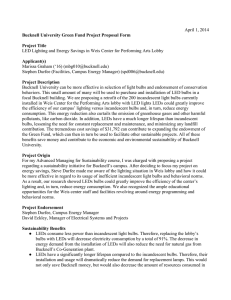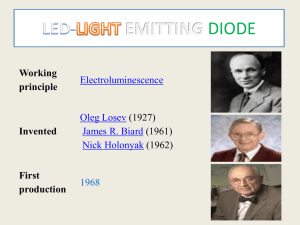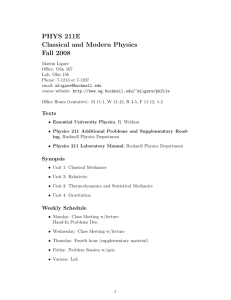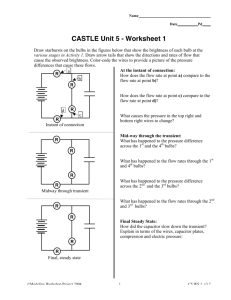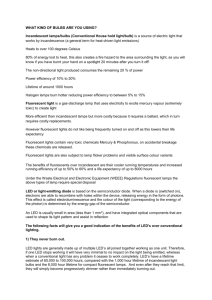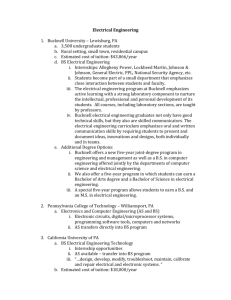LED Lighting in the 7th Street Cafe
advertisement
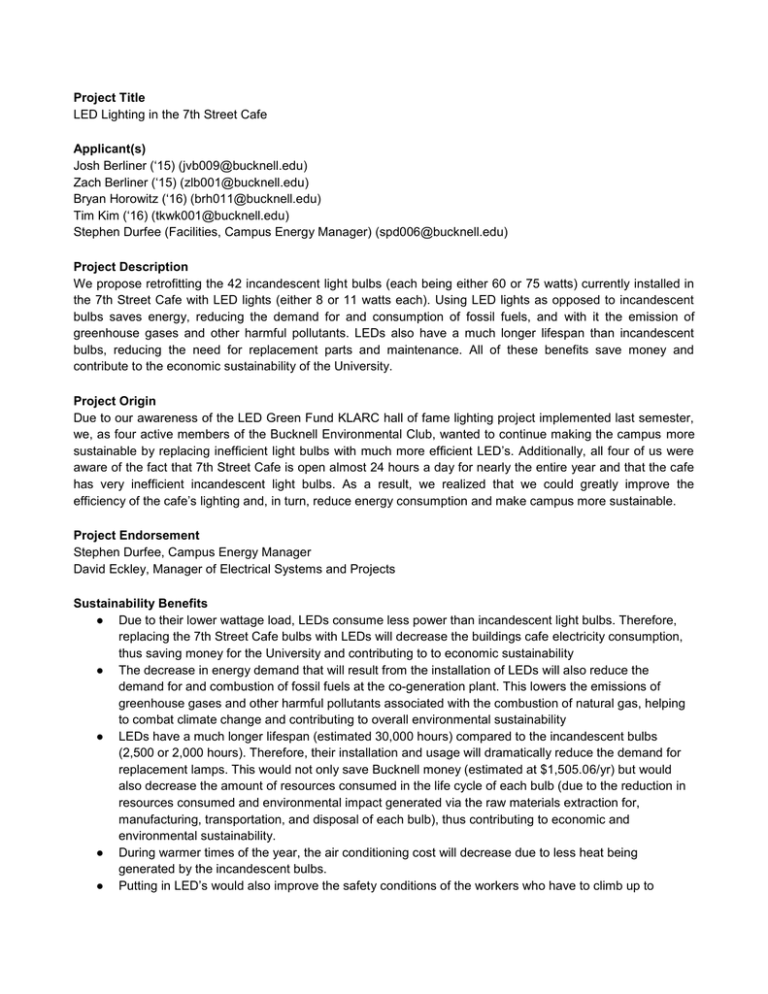
Project Title LED Lighting in the 7th Street Cafe Applicant(s) Josh Berliner (‘15) (jvb009@bucknell.edu) Zach Berliner (‘15) (zlb001@bucknell.edu) Bryan Horowitz (‘16) (brh011@bucknell.edu) Tim Kim (‘16) (tkwk001@bucknell.edu) Stephen Durfee (Facilities, Campus Energy Manager) (spd006@bucknell.edu) Project Description We propose retrofitting the 42 incandescent light bulbs (each being either 60 or 75 watts) currently installed in the 7th Street Cafe with LED lights (either 8 or 11 watts each). Using LED lights as opposed to incandescent bulbs saves energy, reducing the demand for and consumption of fossil fuels, and with it the emission of greenhouse gases and other harmful pollutants. LEDs also have a much longer lifespan than incandescent bulbs, reducing the need for replacement parts and maintenance. All of these benefits save money and contribute to the economic sustainability of the University. Project Origin Due to our awareness of the LED Green Fund KLARC hall of fame lighting project implemented last semester, we, as four active members of the Bucknell Environmental Club, wanted to continue making the campus more sustainable by replacing inefficient light bulbs with much more efficient LED’s. Additionally, all four of us were aware of the fact that 7th Street Cafe is open almost 24 hours a day for nearly the entire year and that the cafe has very inefficient incandescent light bulbs. As a result, we realized that we could greatly improve the efficiency of the cafe’s lighting and, in turn, reduce energy consumption and make campus more sustainable. Project Endorsement Stephen Durfee, Campus Energy Manager David Eckley, Manager of Electrical Systems and Projects Sustainability Benefits ● Due to their lower wattage load, LEDs consume less power than incandescent light bulbs. Therefore, replacing the 7th Street Cafe bulbs with LEDs will decrease the buildings cafe electricity consumption, thus saving money for the University and contributing to to economic sustainability ● The decrease in energy demand that will result from the installation of LEDs will also reduce the demand for and combustion of fossil fuels at the co-generation plant. This lowers the emissions of greenhouse gases and other harmful pollutants associated with the combustion of natural gas, helping to combat climate change and contributing to overall environmental sustainability ● LEDs have a much longer lifespan (estimated 30,000 hours) compared to the incandescent bulbs (2,500 or 2,000 hours). Therefore, their installation and usage will dramatically reduce the demand for replacement lamps. This would not only save Bucknell money (estimated at $1,505.06/yr) but would also decrease the amount of resources consumed in the life cycle of each bulb (due to the reduction in resources consumed and environmental impact generated via the raw materials extraction for, manufacturing, transportation, and disposal of each bulb), thus contributing to economic and environmental sustainability. ● During warmer times of the year, the air conditioning cost will decrease due to less heat being generated by the incandescent bulbs. ● Putting in LED’s would also improve the safety conditions of the workers who have to climb up to replace the light bulbs. By having to replace the bulb every 30,000 hours (every 4 years), as opposed to every 2,500 or 2,000 hours (every 3 to 4 months), this enables the workers to significantly reduce the amount of times they have to possibly risk their safety by climbing up to replace bulbs Sustainability Promotion Opportunities The retrofitting of the 7th Street Cafe with LED lighting provides a few opportunities for the promotion of sustainable practices across campus: ● ● ● This project can serve as an indicator of the feasibility of the installation of LED lighting at Bucknell. Specifically, the data analysis comparing the energy and cost efficiency of the 7th Street Cafe lighting before and after the installation of the LEDs can serve as a means of assessing the viability of LED lighting elsewhere on campus. If deemed viable by this project, LED lighting can become more prevalent on campus and make a larger impression on the campus community relating to sustainability. Placards/signs can be placed in the 7th Street Cafe post-installation describing the project and the sustainability benefits of LED lighting over incandescent light bulbs. We can maintain an online running tally of the energy, money, and pollution savings generated daily, weekly, monthly, etc. by the LED lighting (this information can be found in the attached spreadsheets generated by Josh, Zach, Bryan, and Tim). This would give the campus community more of an insight into how the sustainability of the project has been and will continue to be assessed and provide learning opportunities to students and staff. Projected Project Cost and Savings/Reinvestment Plan (All figures are in U.S. $) Year 0 Year 1 Year 2 Year 3 Year 4 Year 5 Year 6 Year 7 Initial Installation Cost 751.00 - - - - - - - Incandescent Energy Cost - LED Energy Cost - Energy Cost Savings - Incandescent Replacement Cost - 512.64 512.64 512.64 512.64 512.64 512.64 512.64 LED Replacement Cost - 164.40 164.40 164.40 164.40 164.40 164.40 164.40 Replacement Cost Savings - 348.24 348.24 348.24 348.24 348.24 348.24 348.24 Total Savings Per Year 1,404.00 1,404.00 1,404.00 202.18 202.18 202.18 1,201.82 1,201.82 1,201.82 -751.00 1,550.06 1,550.06 1,550.06 1,404.00 202.18 1,201.82 1,550.06 1,404.00 1,404.00 202.18 202.18 1,201.82 1,201.82 1,550.06 1,550.06 1,404.0 0 202.18 1,201.8 2 1,550.0 6 Standard Bucknell conversion rates are available on the Green Fund Website (http://www.bucknell.edu/x64749.xml). Estimated Total Cost ($): 751.00 Estimated Annual Savings ($): 1,201.82 Simple Payback (Years): 0.62 Annual Replacement Bulb Savings (in # of bulbs) Annual Energy Savings (kWh) Cost of Installation Annual Gross Energy Savings Simple Payback Period (in years) Gross Seven Year Savings Net Seven Year Saving (Green Fund Contribution) 118 18,490 $751.00 $1,201.82 .062 $8,412.74 $7,661.74 Additional Data Points required to calculate cost / saving: The LED lights have a 4 year useful life, compared to the current incandescent useful life of 0.3 to 0.4 years. We assumed that the price of energy is $0.065 kW.
